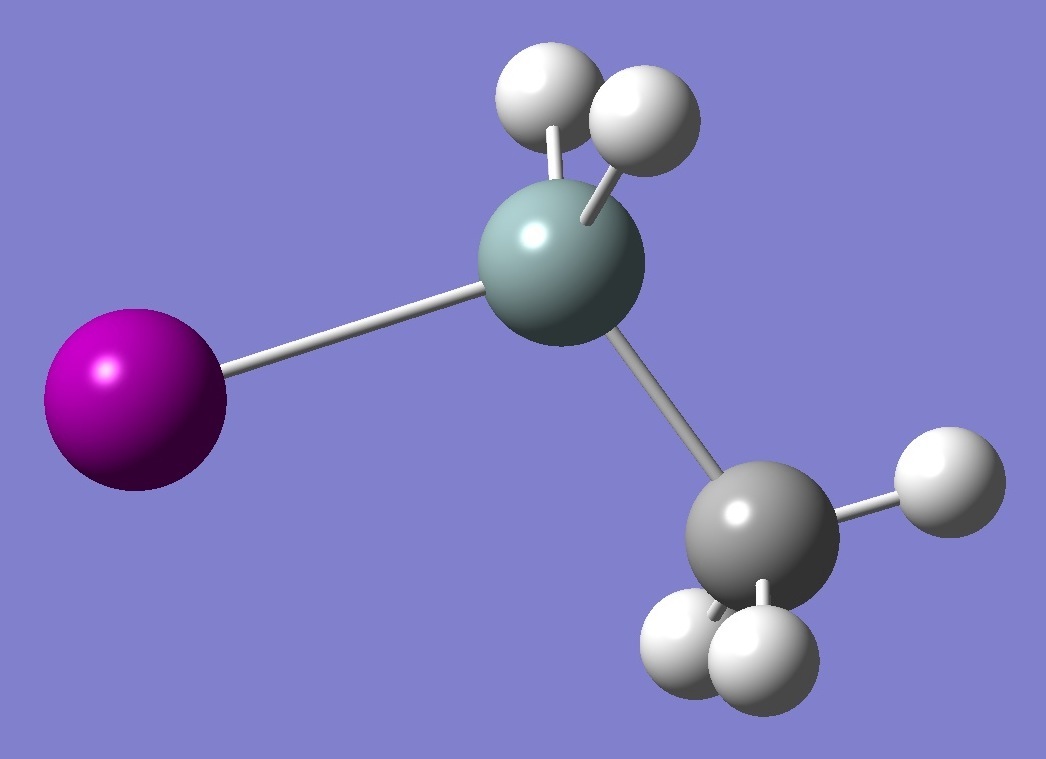|
|
|
|
|
|
|
|
|
|
|
|
|
|
|
|
|
|
|
|
|
SiH2I-CH3 |
|

|
|
|
|
|
|
|
|
|
|
|
|
|
|
|
|
|
|
|
|
|
|
|
|
|
|
|
|
|
|
|
|
|
|
|
Chlorine |
|
|
|
Nuclear
Quadrupole Coupling Constants |
|
|
|
in
Methylsilyliodide |
|
|
|
|
|
|
|
|
|
|
|
|
|
|
|
|
|
|
|
|
|
|
|
|
|
|
|
|
|
|
|
|
|
Calculation was made of the I nqcc
tensor in SiH2I-CH3
on the substitution structure of Hayashi et al. [1]. These
calculated nqcc's are compared with experimental values [2] in Table 1.
Structure
parameters are given in Table 2. |
|
|
|
|
|
|
|
|
|
|
|
|
In Table 1, subscripts a,b,c refer to
the
principal axes of the inertia tensor; x,y,z to the principal axes
of the nqcc tensor. The nqcc y-axis is chosen coincident with the
inertia c-axis, these are perpendicular to the molecular symmetry
plane.
Ø (degrees) is the angle between its subscripted
parameters. ETA = (Xxx - Xyy)/Xzz. |
|
|
RMS is the root mean
square difference between calculated and experimental diagonal nqcc's
(percent of average of magnitudes of experimental nqcc's). RSD is
the calibration residual standard deviation for the B1LYP/6-311G(df,p)
model for calculation of the chlorine nqcc's, which may be taken as an
estimate of the uncertainty in the calculated nqcc's. |
|
|
|
|
|
|
|
|
|
|
|
|
|
|
|
|
|
|
|
|
|
|
| |
|
|
|
|
|
|
|
|
Table 1. Iodine nqcc's
in SiH2I-CH3 (MHz). Calculation was
made on rs structure [1]. |
|
| |
|
|
|
|
|
|
|
|
|
|
|
Calc. |
|
Expt. [2] |
|
| |
|
|
|
|
|
|
|
|
127I |
Xaa |
- |
1025.6 |
- |
1012.65(43) |
|
|
|
Xbb |
|
427.2 |
|
425.35 * |
|
|
|
Xcc |
|
598.3 |
|
587.30 * |
|
|
|
|Xab| |
|
484.4 |
|
478.29(84) |
|
|
|
|
|
|
|
|
|
|
|
RMS |
|
9.9 (1.46 %) |
|
|
|
|
|
RSD |
|
15.2 (1.23 %) |
|
|
|
|
|
|
|
|
|
|
|
|
|
Xxx |
|
574.0 |
|
|
|
|
|
Xyy |
|
598.3 |
|
|
|
|
|
Xzz |
- |
1172.3 |
|
|
|
|
|
ETA |
|
0.0208 |
|
|
|
|
|
Øz,a |
|
16.85 |
|
|
|
|
|
Øa,SiI |
|
16.10 |
|
|
|
|
|
Øz,SiI |
|
0.75 |
|
|
|
|
|
|
|
|
|
|
|
|
|
|
|
|
|
|
|
|
|
|
|
|
* Calculated here from experimental Xaa
and Xbb - Xcc = -161.96(37) MHz. |
|
|
|
|
|
|
|
|
|
|
|
|
|
|
|
|
| Table 2. SiH2I-CH3.
Heavy atom structure parameters, rs [1] (Å and
degrees). Complete structure is given
here in Z-matrix format. |
| |
|
|
|
|
|
rs |
|
|
|
|
|
|
CSi |
1.857(3) |
|
|
SiI |
2.444(2) |
|
|
CSiI |
109.54(18) |
|
|
|
|
|
|
|
|
|
|
|
|
|
|
|
|
|
|
|
|
|
|
|
|
[1] M.Hayashi, M.Fujitake, and
K.Kishioka, J.Mol.Spectrosc. 135,305(1989). |
|
|
[2] M.Fujitake, J.Nakagawa,
and M.Hayashi, J.Mol.Spectrosc. 119,367(1986). |
|
|
|
|
|
|
|
|
|
|
|
|
|
|
|
|
|
|
|
|
|
|
(CH3)3SiI |
CH3CH2I |
SiH3CH2Br |
SiH2ClCH3 |
|
|
|
|
|
|
|
|
|
|
|
|
|
|
|
|
|
|
|
|
|
|
Table of Contents |
|
|
|
|
|
Molecules/Iodine |
|
|
|
|
|
|
|
|
|
|
|
|
|
|
|
|
|
|
|
|
|
|
|
|
|
|
|
|
|
|
SiH2ICH3.html |
|
|
|
|
|
|
Last
Modified 26 March 2009 |
|
|
|
|
|
|
|
|
|
|
